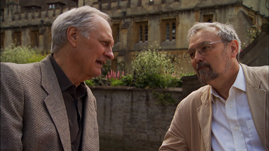Teachers' Domain - Digital Media for the Classroom and Professional Development
User: Preview

Source: The Human Spark: "Brain Matters"




Major funding for The Human Spark is provided by the National Science Foundation, and by the Alfred P. Sloan Foundation. Additional funding is provided by the John Templeton Foundation, the Cheryl and Philip Milstein Family, and The Winston Foundation.
ALAN ALDA The word intentionality is used a lot, and it sounds like it’s in a very special way. What do you mean by intentionality?
ROBIN DUNBAR The term comes really from the philosophy of the mind, the ability to understand or believe things about the world, so any of these mind state things that you can reflect on: I believe, I think, I worry about the weather, and all this kind of stuff. So the question is, can you imagine what other people are also thinking in these kind of ways? So, I wonder what you’re thinking about now. That’s a sort of double intentionality because I’m in an intentional state and I’m imagining your intentional state too.
ALAN ALDA And if I’m thinking about that lady over there, wondering what she’s thinking, and you might be wondering what I’m thinking what she’s thinking…
ROBIN DUNBAR OK, now you’re in third-order intentionality. So in principle, this is an infinite sequence. And where it starts to bite here is that, as far as we know, with possibly a few exceptions, almost all species of birds and mammals operate in what’s called first-order intentionality. So they know the contents of their own minds, right? They think that things are the case.
ALAN ALDA I think I’ll have a worm…
ROBIN DUNBAR Yeah, I believe there’s a worm out there, I’ll go and get it, alright? The doubtful cases become things like the great apes. There’s reasonable evidence, I think that they can manage second-order intentionality; they can understand your mind states, not very well, but they can kind of do it. Now the key is, that’s a big Rubicon for children at about the age of five. Children go through that stage, developmental psychologists call it Theory of Mind, acquiring Theory of Mind, they have a theory about the mind, as it were. But adult humans can run through to fifth-order, it starts to get pretty complicated there. Now I think that you suppose that Jim wants Ella to wonder whether Pete is up to no good. That’s pretty heavy computationally.
ALAN ALDA Why doesn’t it go on to infinity with us?
ROBIN DUNBAR Simply because it’s computationally very demanding. And we can actually show that now, that as you go up through these orders the brain is actually having to work much harder, this comes out of neuroimaging experiments, to handle these high levels. So it’s purely a kind of machine constraint.
 Loading Standards
Loading Standards